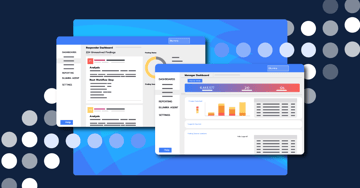This blog post was originally posted in Cybersecurity Insiders.
Businesses today face an ever-increasing number of cyberattacks on average, often posing potential financial impacts in the 7-figure range. Despite this threat, only 55% of organizations have some form of cyber insurance, and only 19% have coverage for cyber events beyond $600,000. The high cost of premiums, which surged in 2022, might contribute to the low percentage of organizations with sufficient coverage.
As the cybersecurity landscape continues to evolve, businesses must carefully evaluate their risk exposure and consider ways to invest in comprehensive cyber insurance policies that truly meet their needs without breaking the bank.
Understanding the Role of Cyber Insurance
Cyber insurance is a financial safeguard against the repercussions of cyberattacks and data breaches. This coverage extends to the expenses associated with data recovery, system restoration and the aftermath of a security breach. Legal actions from affected parties, regulators or business partners following a cyberattack can incur significant costs, all of which cyber insurance can thankfully alleviate.
Cyber insurance policies commonly encompass incident response services, enabling organizations to enlist security experts for breach investigation and mitigation. Some coverage extends beyond mere recovery, encompassing the implementation of security enhancements and measures to prevent future events.
Incorporating cyber insurance is an integral component of a holistic risk management strategy for any organization. It’s important for decision-makers and legal counsel to carefully consider the business’s unique needs and risks when choosing a cyber insurance policy.
Let’s delve into the cybersecurity strategies that IT professionals can adopt to reduce insurance expenses and identify a policy that aligns most effectively with their unique needs.
5 Ways to Lower Costs
IT experts can actively contribute to lowering cyber insurance expenses by showcasing a robust dedication to cybersecurity, effective risk management, regulation adherence and threat awareness.
1. Proactive Risk Management Strategies: Regular risk assessments empower IT professionals to pinpoint vulnerabilities and deploy effective measures for risk mitigation. Consider this: A staggering 98% of organizations globally are linked to breached third-party vendors. To counter the potential impact of a compromised partner or vendor, IT teams should seek to understand the vendor’s cybersecurity protocols. It’s imperative that vendors align with cybersecurity best practices and standards, preventing unauthorized access to sensitive information.
Through a meticulous vetting process of these entities, IT teams fortify their defenses and showcase an unwavering commitment to ongoing enhancements in cybersecurity practices and technologies. Such proactive risk management efforts often translate into more favorable insurance rates from providers who appreciate the dedication to risk prevention.
2. Robust Security Measures: Deploying advanced security solutions like firewalls, intrusion detection systems, encryption and systematic updates plays a pivotal role in curbing cyber insurance expenses by fortifying an organization’s overall cybersecurity framework. Insurers often factor in risk levels when determining premiums, and the efficacy of security software can significantly alleviate potential risks.
Security software doesn’t just safeguard against external threats – it aids in pinpointing and remedying vulnerabilities within other software, applications, systems and networks. The routine execution of vulnerability assessments and patch management, facilitated by reliable security software, contributes to a more resilient environment, diminishing the susceptibility to cyber exploitation.
3. Automated Threat Detection: Implementing security software with advanced threat detection capabilities empowers organizations to identify and respond to security incidents swiftly. Advanced threat detection tools can continuously analyze network traffic, system logs, and user behavior to identify abnormal patterns that may indicate a security breach. By promptly detecting these anomalies, organizations can initiate a rapid response to investigate and contain the threat before it escalates. Timely incident response can constrict the scope and impact of a cyberattack, potentially mitigating the financial losses associated with such incidents.
Companies that utilize modern technologies to monitor for and respond to threats may find insurers willing to extend discounts and offer lower premiums as a recognition of their commitment to cybersecurity.
4. Cybersecurity Compliance: Adopting cybersecurity standards fosters a proactive approach to managing cyber risks and can positively impact cyber insurance costs. Organizations can establish and uphold robust security protocols by aligning with recognized standards and abiding by a structured framework for compliance.
IT teams should prioritize compliance with industry-specific standards and regulatory requirements pertinent to their business sector. Noteworthy cybersecurity standards like ISO 27001, NIST Cybersecurity Framework and PCI DSS offer guidelines for identifying and mitigating cyber risks. By embracing these standards, organizations incorporate best practices into their risk management strategies, lowering the probability of security incidents that necessitate insurance claims.
5. Workforce Education: Despite the evolving technological landscape, the human element remains the primary contributor to cybersecurity incidents, accounting for 74% of total breaches. Well-intentioned employees may inadvertently contribute to security incidents if they lack awareness or training. Incorporating ongoing cybersecurity education is essential because it empowers employees to identify and address potential threats.
A robust training program allows employees to build skills to avoid common pitfalls that could lead to breaches. When the workforce understands cyber risks and best practices, they become less vulnerable to manipulation and less likely to make costly mistakes. Investing in employee education strengthens institutional resilience and signals to partners like insurance providers that the organization takes risk management seriously. Ultimately, equipping staff with knowledge and tools through training fosters a culture of collective responsibility for cybersecurity.
Don’t Wait. Now’s the Time to Prioritize Cyber Insurance.
Given the current threat environment, businesses must strengthen security measures and secure sufficient cyber insurance coverage. The path to lowering cyber insurance costs begins by implementing thorough security measures that diminish risks, and signal to insurers a dedication to addressing potential threats. Taking a proactive approach empowers organizations to protect their digital assets and obtain more economical cyber insurance coverage in the ever-evolving and intricate cybersecurity landscape.
Brett Bzdafka
Brett Bzdafka, Principal Product Manager of Blumira, has had over 10 years of experience in SaaS start-ups that serve SMBs. With background in direct sales, channel sales, project management, product ownership, and product management, Brett knows what it takes for a team to deliver exceptional products to target users...
More from the blog
View All Posts
Implementing Zero Trust Using the NIST Cybersecurity Framework
Read More
Navigating the Complex XDR Landscape: A Guide for SMBs
Read More
Compliance: From Cost Center To Revenue Driver
Read MoreSubscribe to email updates
Stay up-to-date on what's happening at this blog and get additional content about the benefits of subscribing.

